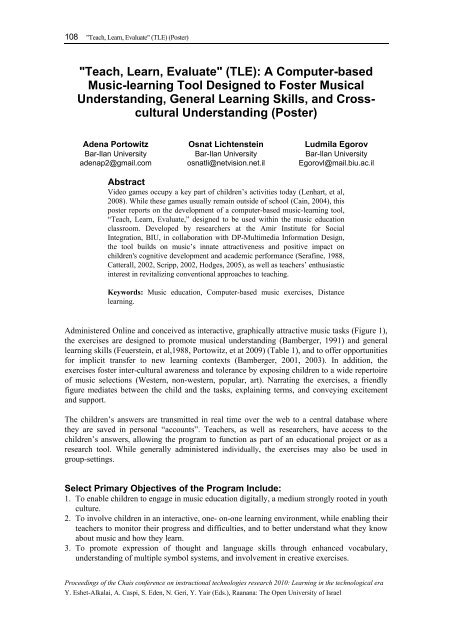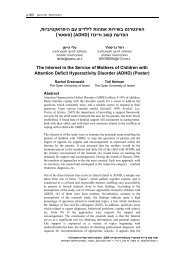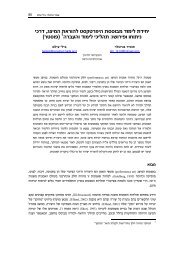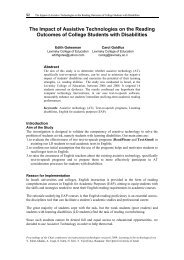"Teach, Learn, Evaluate" (TLE): A Computer-based Music-learning ...
"Teach, Learn, Evaluate" (TLE): A Computer-based Music-learning ...
"Teach, Learn, Evaluate" (TLE): A Computer-based Music-learning ...
You also want an ePaper? Increase the reach of your titles
YUMPU automatically turns print PDFs into web optimized ePapers that Google loves.
108 "<strong>Teach</strong>, <strong>Learn</strong>, Evaluate" (<strong>TLE</strong>) (Poster)"<strong>Teach</strong>, <strong>Learn</strong>, Evaluate" (<strong>TLE</strong>): A <strong>Computer</strong>-<strong>based</strong><strong>Music</strong>-<strong>learning</strong> Tool Designed to Foster <strong>Music</strong>alUnderstanding, General <strong>Learn</strong>ing Skills, and CrossculturalUnderstanding (Poster)Adena PortowitzBar-Ilan Universityadenap2@gmail.comOsnat LichtensteinBar-Ilan Universityosnatli@netvision.net.ilLudmila EgorovBar-Ilan UniversityEgorovl@mail.biu.ac.ilAbstractVideo games occupy a key part of children’s activities today (Lenhart, et al,2008). While these games usually remain outside of school (Cain, 2004), thisposter reports on the development of a computer-<strong>based</strong> music-<strong>learning</strong> tool,“<strong>Teach</strong>, <strong>Learn</strong>, Evaluate,” designed to be used within the music educationclassroom. Developed by researchers at the Amir Institute for SocialIntegration, BIU, in collaboration with DP-Multimedia Information Design,the tool builds on music’s innate attractiveness and positive impact onchildren's cognitive development and academic performance (Serafine, 1988,Catterall, 2002, Scripp, 2002, Hodges, 2005), as well as teachers’ enthusiasticinterest in revitalizing conventional approaches to teaching.Keywords: <strong>Music</strong> education, <strong>Computer</strong>-<strong>based</strong> music exercises, Distance<strong>learning</strong>.Administered Online and conceived as interactive, graphically attractive music tasks (Figure 1),the exercises are designed to promote musical understanding (Bamberger, 1991) and general<strong>learning</strong> skills (Feuerstein, et al,1988, Portowitz, et at 2009) (Table 1), and to offer opportunitiesfor implicit transfer to new <strong>learning</strong> contexts (Bamberger, 2001, 2003). In addition, theexercises foster inter-cultural awareness and tolerance by exposing children to a wide repertoireof music selections (Western, non-western, popular, art). Narrating the exercises, a friendlyfigure mediates between the child and the tasks, explaining terms, and conveying excitementand support.The children’s answers are transmitted in real time over the web to a central database wherethey are saved in personal “accounts”. <strong>Teach</strong>ers, as well as researchers, have access to thechildren’s answers, allowing the program to function as part of an educational project or as aresearch tool. While generally administered individually, the exercises may also be used ingroup-settings.Select Primary Objectives of the Program Include:1. To enable children to engage in music education digitally, a medium strongly rooted in youthculture.2. To involve children in an interactive, one- on-one <strong>learning</strong> environment, while enabling theirteachers to monitor their progress and difficulties, and to better understand what they knowabout music and how they learn.3. To promote expression of thought and language skills through enhanced vocabulary,understanding of multiple symbol systems, and involvement in creative exercises.Proceedings of the Chais conference on instructional technologies research 2010: <strong>Learn</strong>ing in the technological eraY. Eshet-Alkalai, A. Caspi, S. Eden, N. Geri, Y. Yair (Eds.), Raanana: The Open University of Israel
Adena Portowitz, Osnat Lichtenstein, Ludmila Egorov1094. To promote an awareness of similarities and a tolerance of differences among children fromdifferent backgrounds, by establishing communication among children through Internet<strong>based</strong>activities.5. To involve children who normally do not have an opportunity to engage in in-depth musiceducation, because of geographic or financial constraints.6. To foster collaborative research amongst scholars throughout the world.Figure 1. Screenshots from the “<strong>TLE</strong>” ProgramTable 1. General <strong>Learn</strong>ing Skills Developed During <strong>Music</strong> EducationCognitive FunctionAttributesIdentifying patternsThis function involves recognizing patterns or consistencies in thebasic attributes and dimensions of an experience while change istaking place in others.Applied to music, it involves, for example, recognizing musicalentities, despite the transformation of melodic or rhythmic motives.Holistic perceptionThis function fosters creating connections between objects orevents, by encouraging children to compare, organize andcategorize, multiple pieces of information, with the intent ofunderstanding and creating relationships among them.Applied to music, understanding large-scale organizing features,such as contrast, repetition and variation, enables children torecognize musical structures, as for example ABA and Rondoforms.Relating simultaneously to This function involves cognitive processes in which children learnmultiple sources of information to differentiate between and focus upon individual aspects of aand integrating themcomplex phenomenon.During music lessons, children learn to differentiate among pitch,rhythm, dynamics and harmony, and then come to hear the oftenintricate and changing relations among them as a compositionunfolds (Bamberger, 1991, Serafine, 1988).Self-regulationThis function involves ‘thinking before doing’. It reduces impulsivebehavior, and encourages children to think things through so as toavoid random behavior.Applied to music, <strong>learning</strong> to play an instrument alone or in a groupfosters self-discipline and develops strategies that assist inpromoting self-regulation (McPherson & Renwick, 2000).
110 "<strong>Teach</strong>, <strong>Learn</strong>, Evaluate" (<strong>TLE</strong>) (Poster)ReferencesBamberger, J. (1991). The Mind Behind the <strong>Music</strong>al Ear. Cambridge, MA: Harvard University Press.Bamberger, J. (2000). Developing <strong>Music</strong>al Intuitions: A project-<strong>based</strong> introduction to making andunderstanding music. New York: Oxford University Press.Bamberger, J. (2003). <strong>Music</strong> as Embodied Mathematics: A study of a mutually informing affinity (withA. diSessa), International Journal of <strong>Computer</strong>s for Mathematical <strong>Learn</strong>ing, 8, 123-160Cain, T. (2004). Theory, technology, and the music classroom. B.J. <strong>Music</strong> Education, 2, 215-221.Catterall, J. S. (2002). Critical links: <strong>Learn</strong>ing in the arts and student social and academic development.Arts Education Partnership website :http://www.aep-arts.org.Feuerstein, R., Rand, Y. & Rynders, J. E. (1988). Don’t accept me as I am. New York: Plenum Press. 2ndrevised edition, translated into Hebrew, Jerusalem 2001 with new introduction Rafi Feuerstein.Hodges, D. A. (2005). The research agenda to investigate the impact of music education.http://www.uncg.edu/mus/SoundsOf<strong>Learn</strong>ing/SolProject.pdfLenhart, A., Kahne, J., Middaugh, E., Alexandra, M., Evans, C. & Vitak, J. (2008). Teens, Video Gamesand Civics. Research study conducted for the PEW Internet and American Life Project .McPherson, G. E. & Renwick, J. (2000). Self-regulation and musical practice: A longitudinal study.Paper presented at 6th International Conference on <strong>Music</strong> Perception and Cognition, KeeleUniversity, UK.Portowitz, A., Lichtenstein, O., Egorov, L. & Brand, E. (2009). Underlying mechanisms linking musiceducation and cognitive modifiability. Research Studies in <strong>Music</strong> Education, 31,107-128.Scripp, L. (2002). Critical Links: An Overview of research on music and <strong>learning</strong>. <strong>Learn</strong>ing in the artsand student and academic development. Arts Education Partnership website. http://www.aeparts.orgSerafine, M. L. (1988). <strong>Music</strong> Cognition: The development of thought in sound. New York: ColumbiaUniversity Press.






